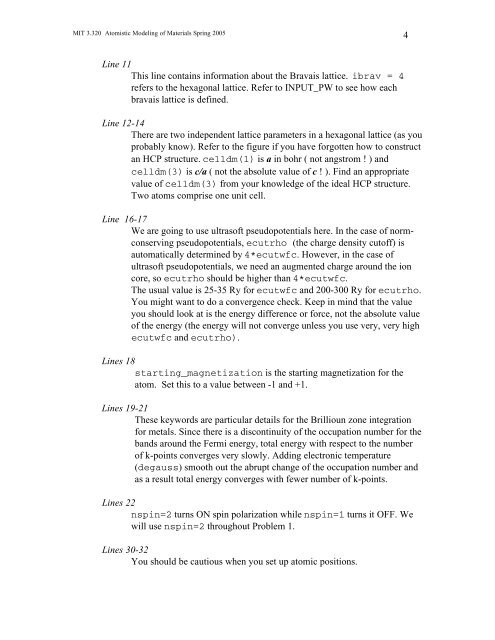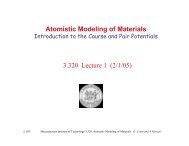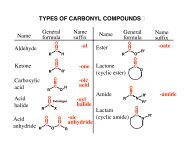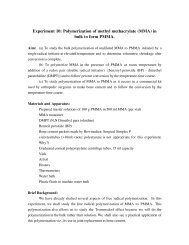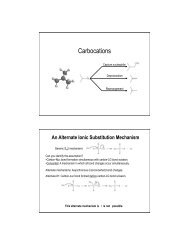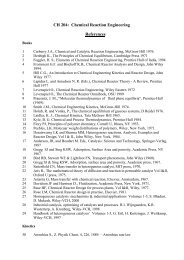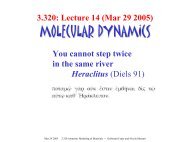Lab 3: Handout Quantum-ESPRESSO: a first principles code, part 2.
Lab 3: Handout Quantum-ESPRESSO: a first principles code, part 2.
Lab 3: Handout Quantum-ESPRESSO: a first principles code, part 2.
Create successful ePaper yourself
Turn your PDF publications into a flip-book with our unique Google optimized e-Paper software.
MIT 3.320 Atomistic Modeling of Materials Spring 2005<br />
4<br />
Line 11<br />
This line contains information about the Bravais lattice. ibrav = 4<br />
refers to the hexagonal lattice. Refer to INPUT_PW to see how each<br />
bravais lattice is defined.<br />
Line 12-14<br />
There are two independent lattice parameters in a hexagonal lattice (as you<br />
probably know). Refer to the figure if you have forgotten how to construct<br />
an HCP structure. celldm(1) is a in bohr ( not angstrom ! ) and<br />
celldm(3) is c/a ( not the absolute value of c ! ). Find an appropriate<br />
value of celldm(3) from your knowledge of the ideal HCP structure.<br />
Two atoms comprise one unit cell.<br />
Line 16-17<br />
We are going to use ultrasoft pseudopotentials here. In the case of normconserving<br />
pseudopotentials, ecutrho (the charge density cutoff) is<br />
automatically determined by 4*ecutwfc. However, in the case of<br />
ultrasoft pseudopotentials, we need an augmented charge around the ion<br />
core, so ecutrho should be higher than 4*ecutwfc.<br />
The usual value is 25-35 Ry for ecutwfc and 200-300 Ry for ecutrho.<br />
You might want to do a convergence check. Keep in mind that the value<br />
you should look at is the energy difference or force, not the absolute value<br />
of the energy (the energy will not converge unless you use very, very high<br />
ecutwfc and ecutrho).<br />
Lines 18<br />
starting_magnetization is the starting magnetization for the<br />
atom. Set this to a value between -1 and +1.<br />
Lines 19-21<br />
These keywords are <strong>part</strong>icular details for the Brillioun zone integration<br />
for metals. Since there is a discontinuity of the occupation number for the<br />
bands around the Fermi energy, total energy with respect to the number<br />
of k-points converges very slowly. Adding electronic temperature<br />
(degauss) smooth out the abrupt change of the occupation number and<br />
as a result total energy converges with fewer number of k-points.<br />
Lines 22<br />
nspin=2 turns ON spin polarization while nspin=1 turns it OFF. We<br />
will use nspin=2 throughout Problem 1.<br />
Lines 30-32<br />
You should be cautious when you set up atomic positions.


